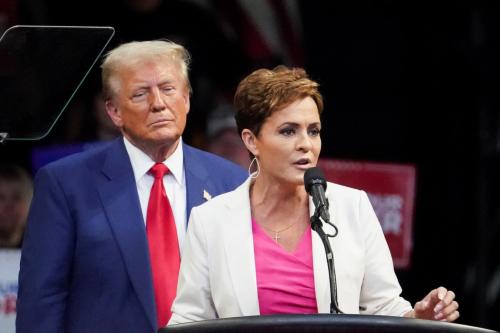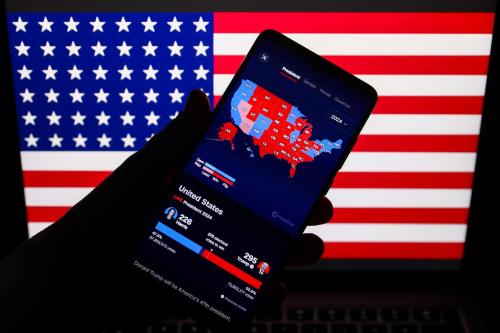Content from the Brookings Doha Center is now archived. In September 2021, after 14 years of impactful partnership, Brookings and the Brookings Doha Center announced that they were ending their affiliation. The Brookings Doha Center is now the Middle East Council on Global Affairs, a separate public policy institution based in Qatar.
This post is the fourth in Pandemic Politics series.
Recent protests in the United States have stirred a debate about whether it is safe to protest during a public health crisis that requires physical distancing. These protests have taken place within a climate saturated with racism, a pandemic, and partisan politics. Anti-racism protests, triggered in response to the killing of George Floyd by a police officer in Minneapolis, have been raging across major U.S. cities. At the same time, several cities have witnessed anti-lockdown protests, such as when armed protesters stormed the Michigan State House to demand that businesses be reopened.
Protesting during a pandemic raises difficult questions. Should the government allow citizens to exercise their First Amendment rights safely, rather than curtail those rights? Should it distinguish between anti-lockdown protests and those against systemic anti-black racism? How does the act of demonstrating during a pandemic expose racial hierarchies?
While some states have tried to ban anti-lockdown protests, Floyd Abrams and John Langford argue that such attempts “run afoul of the First Amendment” and that space for political dissent should be protected. However, Firmin DeBrabander warns that the military demeanor of the armed protesters in Michigan “is not meant to invite discussion; it’s meant to end it.”
Emerson Sykes points to safer alternatives to express dissent, such as online and drive-by protests. But, as Maria O’Sullivan cautions, “online protests are not a substitute for traditional street protests, as they will not necessarily have the same potential to drive change.”
The different positions taken by political groups on both anti-lockdown and anti-black racism protests exposes vast differences in how Americans interpret, exercise, and react to their First Amendment rights. The role of racial identity in influencing such reactions is, as Jamelle Bouie argues, key.
COVID-19 policies must do more than eradicate the disease. They must address and reverse the systemic racism that causes the disproportionate suffering of black and other vulnerable communities at the hands of the virus. The right to protest is an important expression of this demand, even as its recent exercise has painfully exposed entrenched racial hierarchies.
Below is a short selection of commentary for more on this debate.
“The First Amendment sometimes requires discomforting results to protect the liberties of our people.” – Floyd Abrams, Visiting Lecturer at Yale Law School and John Langford, Counsel at Protect Democracy. The Right of the People to Protest Lockdown, May 19, 2020.
“[A]rmed protests are inimical to the traditions of free speech and assembly. When you see protesters in military garb brandishing assault rifles, it does not inspire you to debate them—nor is it intended to.” – Firmin DeBrabander, Professor of philosophy at the Maryland Institute College of Art. The Great Irony of America’s Armed Anti-Lockdown Protesters, May 13, 2020.
“We may need to rely on creative means to protest for some time, but we must remain vigilant to ensure that any safety measures governments put in place are temporary and do not outlive their necessity.” – Emerson Sykes, Staff Attorney at the American Civil Liberties Union. How to Protest in a Pandemic, May 1, 2020.
“[O]ne of the hallmarks of effective protest is its public, visual impact. And often media coverage of protests is a means of garnering greater public support.” – Maria O’Sullivan, Senior Lecturer at and Deputy Director of the Castan Centre for Human Rights Law, Monash University. Is protesting during the pandemic an ‘essential’ right that should be protected? April 21, 2020.
“The great irony, of course, is that this conception of freedom, situated within racial hierarchy and meant to justify deprivation and inequality, has always been impoverished when compared with an expansive, inclusive vision of what it means to be free.” – Jamelle Bouie, Opinion Columnist at The New York Times. The Anti-Lockdown Protesters Have a Twisted Conception of Liberty, May 8, 2020.
The Brookings Institution is committed to quality, independence, and impact.
We are supported by a diverse array of funders. In line with our values and policies, each Brookings publication represents the sole views of its author(s).



Commentary
Op-edPandemic Politics: Is there a right time – and way – to protest during a pandemic?
June 3, 2020